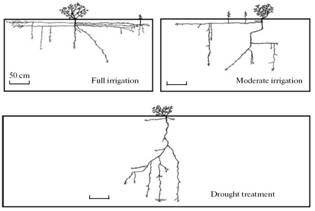Ecological Characteristics of Alhagi sparsifolia Shap. Seedling Roots under Different Irrigation Treatments
2012-06-27
Alhagi sparsifolia Shap., as a dominant perennial species, is distributed widely in a desert-oasis transition zone, which near the southern rim of the Taklimakan Desert with extremely low precipitation. A. sparsifolia grows under high drought and salt stress, and plays an important role in sand stabilization. However, the distribution area of A. sparsifolia is gradually reduced due to unsustainable utilization of this species. Protection and restoration of A. sparsifolia along the outer boundary of the oasis are essential to maintain the stability of the oasis ecosystem. Roots are important for water and nutrient uptake. Availability of water and nutrients are primarily determined by the size, shape and competitiveness of the plant root system, particularly in an ecosystem with limited water. Systematic study on distribution characteristics of A. sparsifolia roots and the relationship between roots and habitat is prerequisite for plant protection and restoration.
Most of the previous researches showed that A. sparsifolia is probably based on permanent access to groundwater to maintain their water supply. But little research reported on relationships between A. sparsifolia seedling roots and soil moisture. Therefore, Professor ZENG Fanjiang and other researchers investigated ecological characteristics of A. sparsifolia seedling roots under different irrigation treatments. This study aims to understand ecological adaptation characteristics of A. sparsifolia seedling roots to water, and provide a theoretical direction and reference for restoration of A. sparsifolia.
The results indicated that under excellent soil moisture conditions, A. sparsifolia seedlings developed many horizontal roots and root sprouts to compete for light. But under poor soil moisture, the vertical root system expanded its resource space into deeper soil. Plasticity of root morphology is an important strategy to capture water and adapt to the hyperarid environment. Root/shoot ratio of A. sparsifolia increased with declining soil moisture, and this trend was more obvious in the growing season. This showed that increasing the root/shoot ratio is another strategy for adapting to drought. The A. sparsifolia seedlings prefer to develop roots in shallower surface soil layers with less water availability. The growth depth and vertical growth rate of roots increased with decreased soil moisture. Biomass and surface area of the root system decreased with increased soil depth, and the total biomass decreased with intensity of soil drought. These findings will provide useful data for effective restoration of A. sparsifolia and better utilization of water resources in hyperarid regions.
The result has been published on Russian Journal of Ecology, 2012, 43(3): 196-203. The paper is also archived at http://www.springerlink.com/content/3t857m43583j7203/.

Root morphological characteristics of A. sparsifolia seedling roots under different irrigation treatments. (Image by XIEG)



